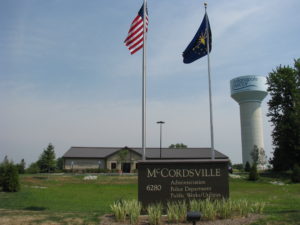McCordsville, Indiana
When a town manager is engaged and monitoring events that can affect her jurisdiction, changes can be managed with little disruption or opposition.
This is evidenced by the successful annexation of about 1,000 acres of land and five miles of road by McCordsville, Indiana, that helped the mostly residential community respond to and prepare for explosive growth.
Because McCordsville borders Indianapolis in Marion County and Fishers in Hamilton County, it was clear that growth issues were headed toward McCordsville and it seemed prudent to take steps before it was too late to control the growth and the location of non-residential expansion, says McCordsville Town Manager, Tonya Galbraith.
“This process is valuable to any small town that anticipates growth and wants to know the best way to manage it,” she adds. “Two towns in our county also were attempting to annex at the same time we were and they both went to court. The Indiana Supreme Court ruled against one of the annexations and the other is still in court. I strongly believe that the thoughtful and thorough process that we went through is the reason we succeeded.”

McCordsville Town Building
Explosive Growth
From 2000 to 2010, McCordsville witnessed an unprecedented 323 percent population increase and residential building permits continue to be on the rise. The challenge was to balance the tax base while protecting local property values and the quality of life that nearly 7,000 residents enjoy, Galbraith said. The town’s population was just under 1,200 in 2005.
At its 2012 retreat, the town council began wrestling with how to address the growth challenge.
The State of Indiana had instituted Constitutional Property Tax Caps and it became clear that the tax caps, namely the residential caps, were going to affect the town’s bottom line. Town leadership recognized that responsible growth was the key to protecting the area’s character and way of life. So they embarked on a “Growth Opportunity” planning project, exploring possibilities outside the boundaries of McCordsville for logical commercial and industrial expansion.
Galbraith was charged with writing an innovative Request for Proposals (RFP) to develop a comprehensive, multi-faceted approach for identifying growth opportunity areas. The RFP drew upon the council’s vision and proposed a variety of tasks including:
- Site reconnaissance,
- Review of project data,
- Identifying the town’s commitment for resources, services, and utilities,
- Identifying stakeholders who may resist or support incorporation,
- Meeting with the various stakeholder groups (elected officials, business leaders, property owners), and
- Working with the McCordsville Redevelopment Commission.
A team of five firms was chosen to work together on the project.
Armed with this information at its 2013 retreat, town council identified an area south of McCordsville as the most logical for growth and directed the team and staff to study the implications of incorporation. Information was needed to determine how far south to incorporate, how much the town could afford.
Internally, town staff developed seven fiscal plans, coordinated by Galbraith. The fiscal plans were based on various iterations of a South District Annexation. In the end, an area of 1,132 acres and 5.3 road miles was identified for annexation.
In March of 2014 the town council began the annexation process by introducing an ordinance along with publishing a document that describes the process, implications to property owners, and the owners’ rights during the process. This document was sent to 142 property owners in the annexation area.
A public hearing was held in August of 2014 where only four people spoke against the proposed ordinance. It was adopted in October of 2014 and on Jan. 19, 2015 the annexation became effective.
Galbraith said community partnership, civic engagement, and local government innovation helped the project run smoothly and identified three keys to its success:
- Anticipated aspirations for the future: Local government leadership identified land use that reflects community desires, like a new town center, future transportation, and development opportunities.
- Cultivated community: Input from residents and current business owners ensured local sentiment was valued, and outreach to potential developers guaranteed an external perspective on the realities of growth.
- Applied comprehensive approach: The combination of studying utility availability; tax impact versus revenue; transportation barriers; internal and external stakeholder contributions; and land use issues, created a unique and holistic approach to growth planning.
The town spent about $30,000 on the project and several tracts of farm land, which are zoned for light industrial or commercial use, are up for sale along the busy road called Mt. Comfort.
McCordsville joined with another town also along the same corridor to get grant funding to help articulate the economic benefits to residents of developing the tracts and what type of development would generate the most jobs, or property tax, Galbraith said. See the impact study here.
To learn more about McCordsville visit: McCordsville Facebook page; Twitter Handle, @McCordsvilleIN; or website.
Meet the Manager

